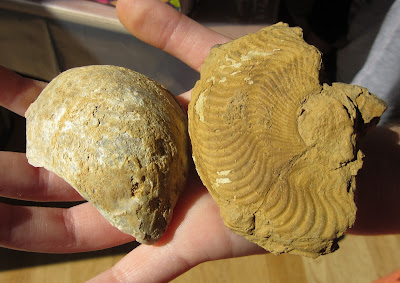The fungi seem to have really burst into life over the last week, with all sorts of little treasures popping up. They're neither plants nor animals and belong to their own classification kingdom. The part we see above ground is just the fruit and the main body actually stretch underground. They're a vital part of the woodland ecology, helping with the decaying process, providing food and homes to many creatures and forming complex relationships with plants and trees.
Today I decided to take a look 'off road', climbing up the side of Pulpit Hill through the trees instead of on the path. It was very steep and my nerves weren't helped by the dog playing a game of racing down the hill and skidding through the leaf litter into me, but it was worth it because often you find the best things by veering off into the wilderness a little.
I chose to climb up at that spot because I'd heard that bird's-nest orchids grew up there, so thought it might be a chance to check out the area and look for some fungi at the same time. I'm fairly sure I found the orchids and there were around 30 stems in a small area. They've gone to seed now but at least I know where to look next spring.
 |
| I'm hoping these are bird's-nest orchids |
I found some interesting fungi whilst I was there. With branched, pointed tips and flattened stems I believe this must be crested coral fungus. It's usually white but can sometimes be cream or ochre, as in this case.
This large, deep red fungus was growing on a fallen log. I think it must be an oyster mushroom, but they're usually white or grey. This was a lovely rich burgundy colour and was quite unusual with a very tough, leathery cap and a white, off-center stem.
I also saw one of the huge Roman snails on the move. We see them regularly on Pulpit Hill during the Spring, but I hadn't seen any for a while and thought they might have hibernated already.
Yesterday we took the dog for a walk on Chinnor Hill, another favourite fungi haunt and found this newly emerged magpie inkcap 'egg'. It will open out into the distinctive inkcap bell shape within the next day and will have 'dripped' away and disintegrated within about another two days.
 |
| Magpie inkcap |
We saw several distinctive fungi in different stages of growth. They looked similar to fly agaric (red fairy toadstalls with white spots) but the cap was grey with a hint of pink. They were covered in cream coloured 'warts' and had white, crowded gills. I believe these are either grey spotted amanita or a fungi called the blusher, but I'm not sure which. Both are in the amanita family and are related to the fly agaric.
 |
| Just emerging our of the leaf litter |
This fairy ring was hiding in the leaf litter and was made up of clumps of little peach bonnets with grey stems. Tradition has it they're formed where the fairies dance around in a circle, but we didn't see any fairies!
These tiny little collared parachutes were covering the woodland floor. Such delicate little things that you could easily completely miss them.
Finally, the base of a tree was covered in little puffballs. The fact that they were growing on wood makes them stump puffballs instead of common puffballs which grow out of the ground. Some lovely decoration for the tree!

































































